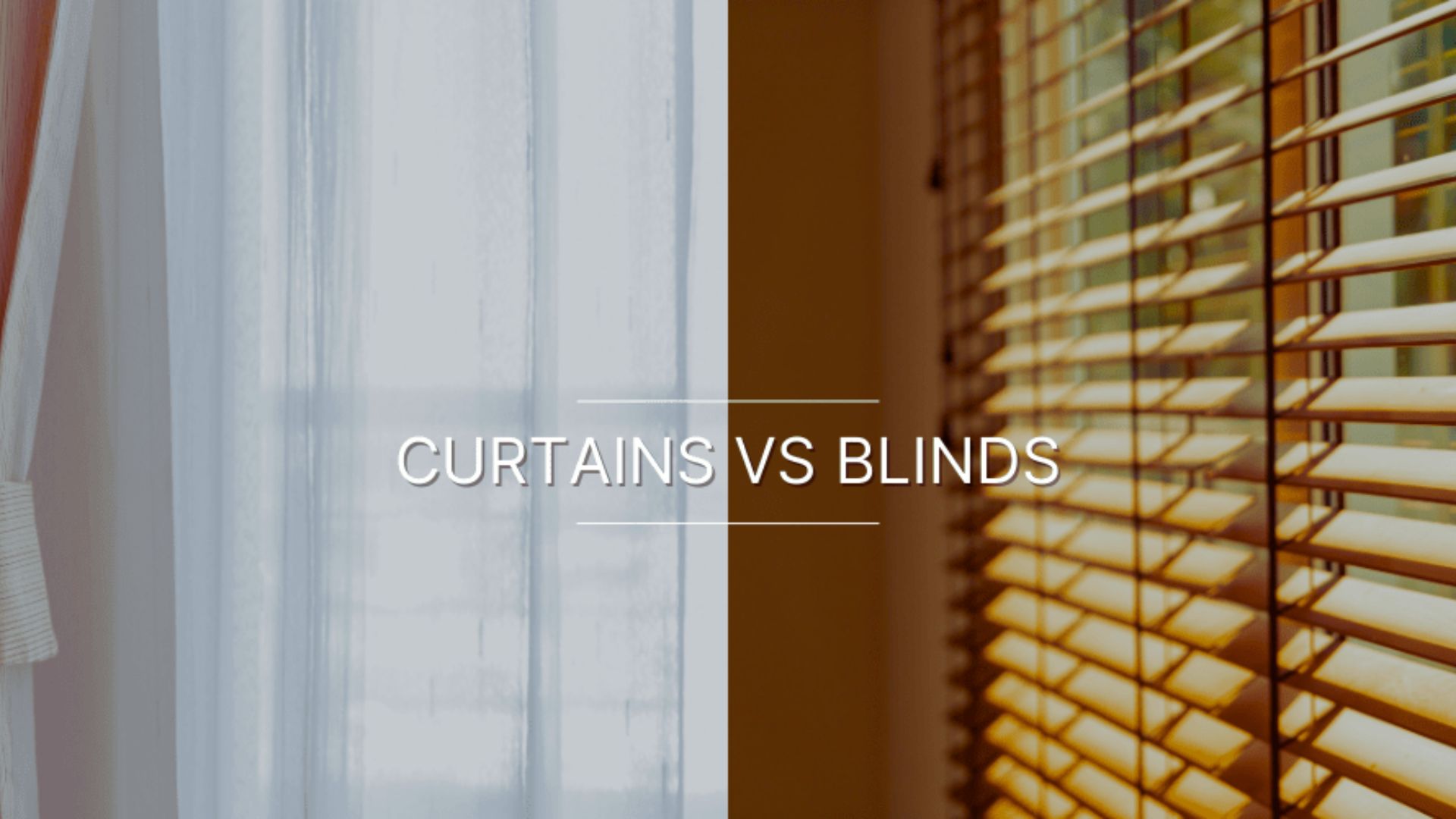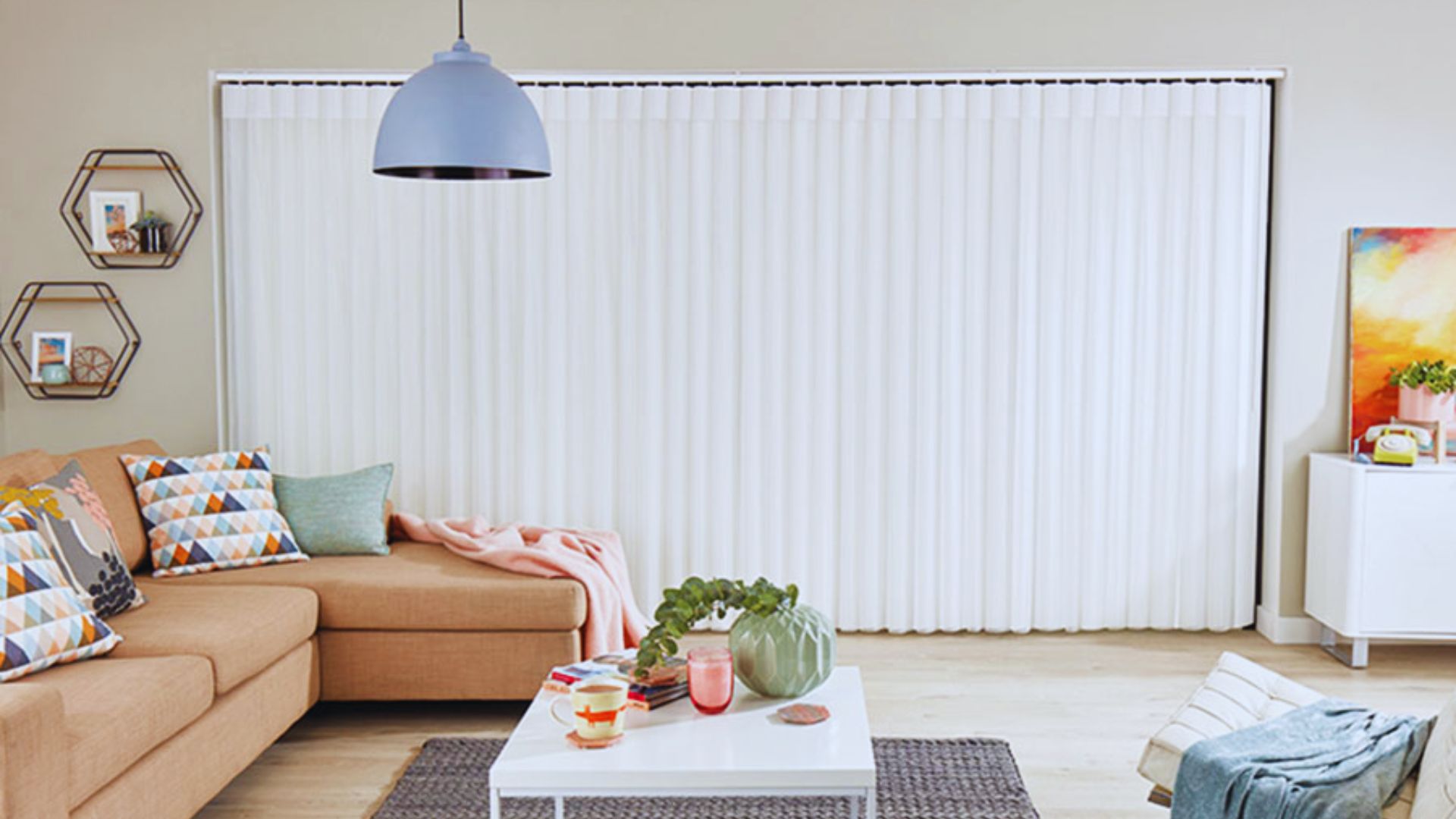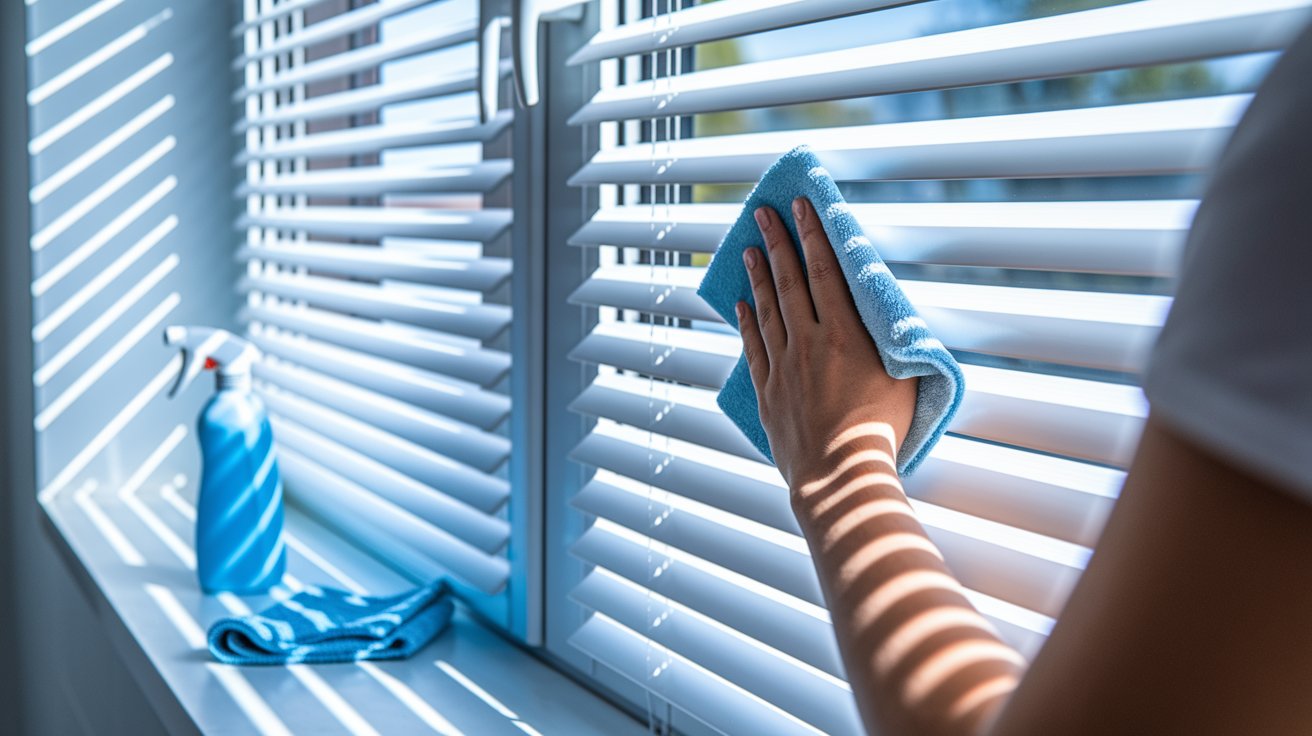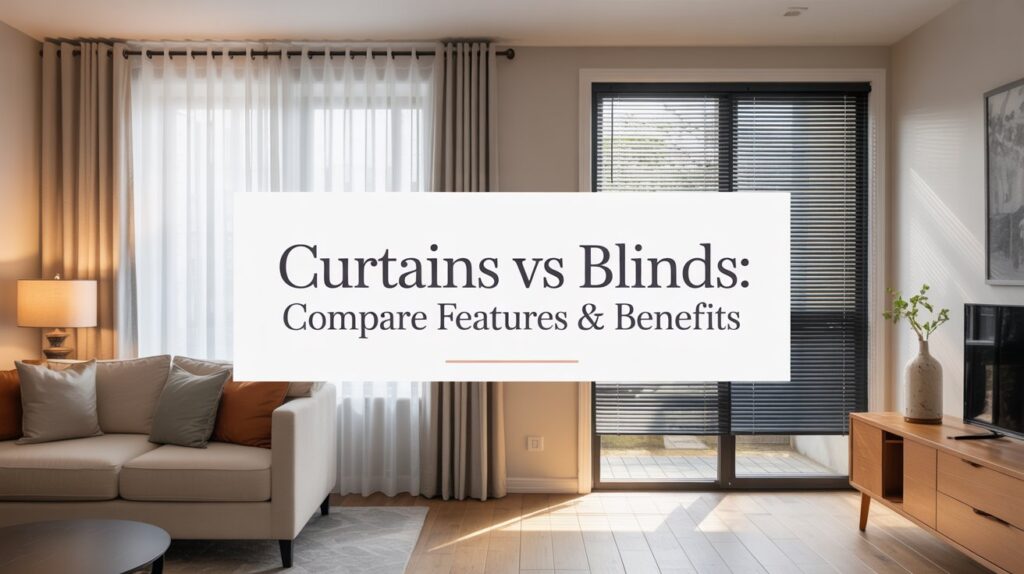Choosing between curtains vs blinds can feel overwhelming. I’ve been there myself, staring at bare windows and wondering what would work best.
In this guide, I’ll walk you through everything you need to know to make the right choice for your home.
We’ll cover light control, privacy, style options, maintenance needs, and costs. I’ll also share which rooms work best for each option and when combining both makes sense.
You’ll get honest, straightforward advice based on real experience.
By the end, you’ll know exactly which window treatment fits your lifestyle. No confusing jargon. No pushy sales talk. Just practical help to solve your window covering dilemma.
Understanding Curtains and Blinds

Before we compare options, let’s get clear on what each one actually is. Understanding the basics helps you make smarter decisions for your space.
Curtains are soft fabric panels that hang beside or over your windows. They come in fabrics like cotton, linen, velvet, and polyester.
You’ll find sheer curtains that let light through, blackout curtains that block everything, and thermal curtains that help with temperature control. Most homes use curtains in living spaces and bedrooms where they add softness and warmth.
Blinds are hard window coverings made with slats or vanes that tilt open and closed. Common materials include wood, faux wood, aluminum, and vinyl.
You pull a cord or twist a wand to adjust them, though newer models offer cordless or motorized options. People typically use blinds in kitchens, bathrooms, and offices because they’re practical and easy to clean.
Key Differences Between Curtains and Blinds
Now let’s compare how these two options actually perform in your home. These differences matter for daily living.
| Feature | Curtains | Blinds |
| Light Control | Sheer fabrics filter light gently. Heavier fabrics block most light but don’t offer adjustability. You either open them or close them. For complete darkness, blackout curtains win. | Give you precise control over brightness. Tilt slats partially open for soft light. Close completely for darkness. Adjust throughout the day as the sun moves. Work better for rooms with harsh morning sun. |
| Privacy | Provide full coverage when closed. Nobody sees through them. But you lose the middle ground where you get light without exposure. | Let you balance privacy with light. Close slats downward and people can’t see in, but light still enters. It’s a flexible system. |
| Style and Aesthetics | Bring beauty and softness to spaces. Come in many colors, patterns, and textures. Long flowing curtains make rooms feel taller. Rich fabrics add luxury. Even simple cotton creates a cozy feeling. | Offer clean, modern lines. Streamlined and unobtrusive. Perfect for minimalist or contemporary spaces. Wooden blinds add natural warmth. Aluminum feels industrial. |
| Durability and Moisture Resistance | Struggle with moisture unless you choose specific fabrics. Natural materials like cotton can develop mildew. Synthetic fabrics resist moisture better but need regular washing. Work best in dry living spaces. | Handle humidity like champions. Vinyl and aluminum resist moisture completely. Won’t warp, mold, or mildew in bathrooms and kitchens. Clear winner for humid rooms. |
| Maintenance and Cleaning | Requires more effort. Light fabrics need washing every few months. Heavy drapes might need professional dry cleaning. You take them down, clean them, and rehang them. | Take minutes to clean. Dust weekly with a microfiber cloth. Wipe slats with a damp cloth for deeper cleaning. Save time and hassle. |
| Cost Considerations | Designer curtains with hardware can cost hundreds. Fade, tear, or go out of style faster. Professional cleaning adds up over time. Ready-made curtains offer affordable options. | Basic vinyl blinds start around twenty to thirty dollars per window. Quality blinds last ten to fifteen years with minimal replacement needs. Only need occasional deep cleaning you can do yourself. |
| Soundproofing and Insulation | Excel at temperature control. Heavy, lined curtains trap air between fabric and window. Keep rooms warmer in winter and cooler in summer. Muffle outside noise. Thick fabric absorbs sound waves. Great for bedrooms facing busy streets. | Provide some insulation, especially cellular or honeycomb styles. Can’t match heavy curtains for thermal or sound blocking. Offer basic temperature help with better light control. |
Light Control

Blinds give you precise control over brightness. Tilt the slats partially open for soft light. Close them completely for darkness. Adjust throughout the day as the sun moves.
Curtains work differently. Sheer fabrics filter light gently. Heavier fabrics block most light but don’t offer the same adjustability. You either open them or close them.
For rooms with harsh morning sun, blinds work better. You can redirect light without losing all visibility. For bedrooms where you want complete darkness, blackout curtains win.
Privacy

Blinds let you balance privacy with light. Close the slats downward and people can’t see in, but light still enters. It’s a flexible system.
Curtains provide full coverage when closed. Nobody sees through them. But you lose that middle ground where you get light without exposure.
Want the best of both? Layer blinds behind curtains. Use blinds during the day for privacy with light. Close curtains at night for complete seclusion.
Style and Aesthetics

Curtains bring beauty and softness to spaces. They come in many colors, patterns, and textures. You can match them to any décor style from traditional to bohemian.
Long flowing curtains make rooms feel taller. Rich fabrics add luxury. Even simple cotton curtains create a cozy, lived-in feeling.
Blinds offer clean, modern lines. They’re streamlined and unobtrusive. Perfect for minimalist or contemporary spaces where you want function without fuss.
Wooden blinds add natural warmth. Aluminum blinds feel industrial. The style depends on material choice.
Durability and Moisture Resistance

Blinds handle humidity like champions. Vinyl and aluminum blinds resist moisture completely. They won’t warp, mold, or mildew in bathrooms and kitchens.
Wood blinds are less moisture-friendly but still more durable than fabric in damp spaces. Faux wood offers a good compromise.
Curtains struggle with moisture unless you choose specific fabrics. Natural materials like cotton can develop mildew. Synthetic fabrics resist moisture better but still need regular washing.
For humid rooms, blinds are the clear winner. For dry living spaces, either option lasts years with proper care.
Maintenance and Cleaning

Cleaning blinds takes minutes. Dust them weekly with a microfiber cloth or duster. For deeper cleaning, wipe slats with a damp cloth. Vinyl and aluminum blinds can even handle spray cleaners.
Curtains require more effort. Light fabrics need washing every few months. Heavy drapes might need professional dry cleaning. You have to take them down, clean them, and rehang them.
Some curtains are machine washable, which helps. But it’s still more work than wiping down blinds.
If you want low-maintenance window treatments, blinds save time and hassle.
Cost Considerations

Initial costs vary widely for both options. Basic vinyl blinds start around twenty to thirty dollars per window. Designer curtains with hardware can cost hundreds.
Think long-term though. Quality blinds last ten to fifteen years with minimal replacement needs. Curtains fade, tear, or go out of style faster.
Budget options exist for both. Ready-made curtains are affordable. Standard-size blinds cost less than custom orders.
Factor in cleaning costs too. Professional curtain cleaning adds up over time. Blinds need only occasional deep cleaning you can do yourself.
Soundproofing and Insulation

Curtains excel at temperature control. Heavy, lined curtains trap air between fabric and window. This keeps rooms warmer in winter and cooler in summer.
They also muffle outside noise. Thick fabric absorbs sound waves that hard surfaces reflect. Great for bedrooms facing busy streets.
Blinds provide some insulation, especially cellular or honeycomb styles. But they can’t match heavy curtains for thermal or sound blocking.
For energy efficiency and quiet, curtains with thermal lining are your friend. For basic temperature help with better light control, consider both together.
When to Choose Curtains or Blinds
Location matters. Some rooms work better with one option over the other. Let me break it down by space.
- Living rooms and bedrooms work best with curtains. They frame windows beautifully and provide the light-blocking power needed for restful sleep. You can change them seasonally to refresh your space.
- Bathrooms and kitchens need blinds. These rooms require moisture resistance and easy cleaning. Blinds wipe clean in seconds while curtains would absorb odors and stains.
- Home offices and utility spaces favor blinds. You can adjust light throughout the workday without getting up constantly. They deliver practical function without decorative effort.
- Formal dining rooms shine with floor-length curtains. They add sophistication for special occasions while creating a warm atmosphere that blinds can’t match.
- Layering both gives maximum flexibility. Install blinds for light control, then add curtains for style and insulation. This combination costs more upfront but solves multiple problems at once.
Conclusion
Curtains versus blinds exist. The best option for your home is the main factor and mixing window treatments gives a nice balance.
What is effective for you back at home? Comment below to share your setup.
Tell me the reason for that choice. And if you’re still deciding, you can check them out now. Our window treatment guides may inspire you.
Something that makes you smile every time you walk in is deserved by your space.
Frequently Asked Questions
Can you use curtains and blinds together?
Yes, layering both works wonderfully. Blinds provide light control while curtains add style and insulation for maximum flexibility.
Which is easier to install?
Blinds install faster with simple brackets. Curtains need rods and hardware but both are doable for beginners with basic tools.
Do curtains or blinds last longer?
Quality blinds last ten to fifteen years with minimal wear. Curtains fade and need replacement every five to eight years.
Which option is better for allergies?
Blinds collect less dust and clean easier, making them better for allergy sufferers. Curtains trap allergens in fabric fibers.
Are blinds or curtains more energy efficient?
Heavy thermal curtains provide superior insulation. For maximum savings, use insulated curtains with cellular blinds underneath.

